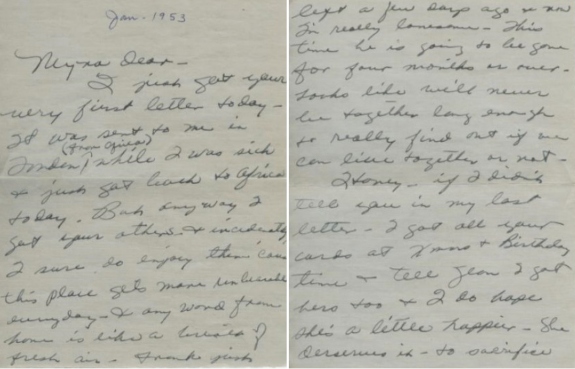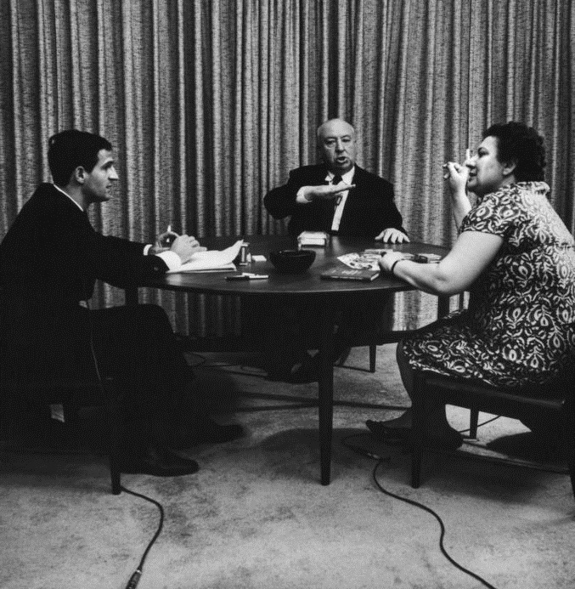While I'm not familiar with his work, François Truffaut was one of France's most respected filmmakers and one of the founders of the French movement La Nouvelle Vague (The New Wave). His films include such classics as The 400 Blows (1959), Jules and Jim (1962) and Day For Night (1973). Not having seen any of his films yet, I must say I only associate Truffaut with Alfred Hitchcock with whom he conducted a series of interviews in the summer of 1962.
Truffaut was a huge fan of Hitchcock and was the first to recognise him as a complete and serious filmmaker and not just a mainstream director of entertaining suspense films. By the early 1960s, Hitchcock was at the height of his career but many critics (both American and European) still belittled his work, feeling it lacked substance. To prove the critics wrong, Truffaut came up with the idea to do in-depth interviews with Hitchcock during which they would explore and analyse his work. The interviews were recorded and eventually compiled into the book Hitchcock/Truffaut, which is still considered the definitive study on Hitchcock (the French edition was published in 1966, the English edition in 1967). As had been Truffaut's objective, critics started to change their attitude towards Hitchcock and eventually took his work more seriously.
Paris, 2 June 1962
Dear Mr Hitchcock,
First of all, allow me to remind you who I am. A few years ago, in late 1954, when I was a film journalist, I came with my friend Claude Chabrol to interview you at the Saint-Maurice studio where you were directing the post-synchronization of To Catch a Thief. You asked us to go and wait for you in the studio bar, and it was then that, in the excitement of having watched fifteen times in succession a ‘loop’ showing Brigitte Auber and Cary Grant in a speedboat, Chabrol and I fell into the frozen tank in the studio courtyard.
You very kindly agreed to postpone the interview which was conducted that same evening at your hotel.
Subsequently, each time you visited Paris, I had the pleasure of meeting you with Odette Ferry, and for the following year you even said to me, ‘Whenever I see ice cubes in a glass of whisky I think of you.’ One year after that, you invited me to come to New York for a few days and watch the shooting of The Wrong Man, but I had to decline the invitation since, a few months after Claude Chabrol, I turned to film-making myself.
I have made three films, the first of which, The Four Hundred Blows, had, I believe, a certain success in Hollywood. The latest, Jules et Jim, is currently showing in New York.
I come now to the point of my letter. In the course of my discussions with foreign journalists and especially in New York, I have come to realize that their conception of your work is often very superficial. Moreover, the kind of propaganda that we were responsible for in
Cahiers du Cinéma was excellent as far as France was concerned, but inappropriate for America because it was too intellectual.
Since I have become a director myself, my admiration for you has in no way weakened; on the contrary, it has grown stronger and changed in nature. There are many directors with a love for the cinema, but what you possess is a love of celluloid itself and it is that which I would like to talk to you about.
I would like you to grant me a tape-recorded interview which would take about eight days to conduct and would add up to about thirty hours of recordings. The point of this would be to distil not a series of articles but an entire book which would be published simultaneously in New York (I would consider offering it, for example, to Simon and Schuster where I have some friends) and Paris (by Gallimard or Robert Laffont), then, probably later, more or less everywhere in the world.
If the idea were to appeal to you, and you agreed to do it, here is how I think we might proceed: I could come and stay for about ten days wherever it would be most convenient for you. From New York I would bring with me Miss Helen Scott who would be the ideal interpreter; she carries out simultaneous translations at such speed that we would have the impression of speaking to one another without any intermediary and, working as she does at the French Film Office in New York, she is also completely familiar with the vocabulary of the cinema. She and I would take rooms in the hotel closest to your home or to whichever office you might arrange.
Here is the work schedule. Just a very detailed interview in chronological order. To start with, some biographical notes, then the first jobs you had before entering the film industry, then your stay in Berlin. This would be followed by:
1. the British silent films;
2. the British sound films;
3. the first American films for Selznick and the spy films;
4. the two ‘Transatlantic Pictures’
5. the Vistavision period;
6. from The Wrong Man to the The Birds.
The questions would focus more precisely on:
a) the circumstances surrounding the inception of each film;
b) the development and construction of the screenplay;
c) the stylistic problems peculiar to each film;
d) the situation of the film in relation to those preceding it;
e) your own assessment of the artistic and commercial result in relation to your intentions.
There would be questions of a more general nature on: good and bad scripts, different styles of dialogue, the direction of actors, the art of editing, the development of new techniques, special effects and colour. These would be interspaced among the different categories in order to prevent any interruption in chronology.
The body of work would be preceded by a text which I would write myself and which might be summarized as follows: if, overnight, the cinema had to do without its soundtrack and became once again a silent art, then many directors would be forced into unemployment, but, among the survivors, there would be Alfred Hitchcock and everyone would realize at last that he is the greatest film director in the world.
If this project interests you, I would ask you to let me know how you would like to proceed. I imagine that you are in the process of editing The Birds, and perhaps you would prefer to wait a while?
For my part, at the end of this year I am due to make my next films, an adaptation of a novel by Ray Bradbury, Fahrenheit 451, which is why I would prefer the interviews to take place between 15 July and 15 September 1962.
If you were to accept the proposition, I would gather together all the documents I would need to prepare the four or five hundred questions which I wish to ask you, and I would have the Brussels Cinémathèque screen for me those films of yours with which I am least familiar. That would take me about three weeks, which would mean I could be at your disposal from the beginning of July.
A few weeks after our interviews, the transcribed, edited and corrected text would be submitted to you in English so that you might make any corrections that you considered useful, and the book itself would be ready to come out by the end of this year.
Awaiting your reply, I beg you to accept, dear Mr Hitchcock, my profound admiration. I remain
Yours sincerely,
Francois Truffaut
































